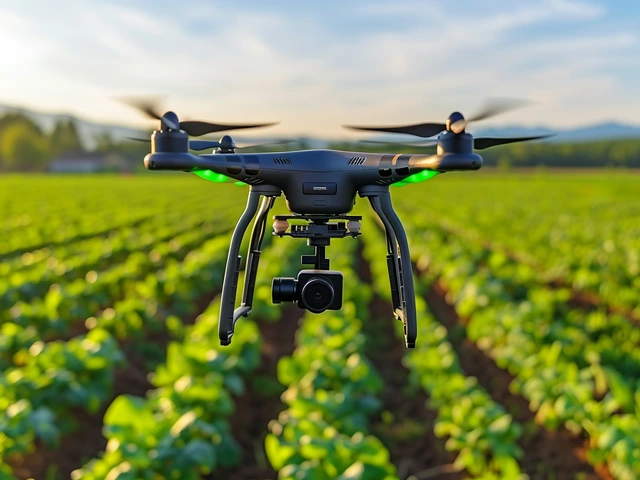Understanding Python for Artificial Intelligence: A Comprehensive Guide for Beginners

Understanding Python for Artificial Intelligence: A Comprehensive Guide for Beginners
Unraveling the Snake: Why Python is AI's Best Pal
Python may sound like something straight out of the Indiana Jones franchise, but rest assured, this serpent poses no threat. In the realm of artificial intelligence, Python isn't just a slithering reptile but rather the programming equivalent of a Swiss Army knife. Its popularity isn't just by chance or fancy branding – oh no, it's because Python is as versatile as a chameleon changing its colors to blend into a disco. But why does it get along with AI like peanut butter does with jelly, or better yet, like my Einstein gets along with a thrown tennis ball? That's exactly what we're about to demystify!
First things first, Python's simplicity is its ultimate charm. Imagine trying to write a novel using only a Morse code transmitter. That’s what using other, more complex programming languages can feel like in comparison. Python, however, is like chatting with an old friend. It’s expressive and readable, meaning you can spend more time on the real fun puzzle-solving part of AI, and less on deciphering what your code is trying to tell you.
But it's not just about being user-friendly. Python's got libraries – oh, so many libraries! If you were to visualize these libraries, picture a colossal buffet where every conceivable dish from around the world is at your fingertips. In Python's case, these 'dishes' are tools and modules specifically crafted to aid in AI and machine learning. With these at your disposal, you could whip up a recipe for a neural network or sauté some deep learning algorithms, all before you've finished your morning cuppa.
Setting Up Your Python Playground
Now, let's dive into setting up our digital sandbox so we can start playing. Installing Python is as easy as pie – not Python pie, mind you, although if my kids, Rowan and Aislinn, could bake a Python pie, they most definitely would. Much like setting up an epic Lego set, you'll begin by downloading Python onto your computer. By visiting Python's official website, you can download the latest version faster than you can say 'abracadabra'. But the magic doesn't stop there, because you'll also need an Integrated Development Environment, or IDE for short, which is essentially your magical workshop for coding spells.
Once you've selected an IDE like PyCharm or VSCode, merely install that to hop onto the next step. Now, remember that buffet of libraries I mentioned earlier? It's time to fill your plate! Tools like NumPy and pandas will be your bread and butter for handling data, because in AI, data is king, queen, and the entire royal court. You'll use packages like Matplotlib to craft visual masterpieces from your data, drawing meaningful insights with the stroke of a brush... or code.
And the crown jewels of our Python AI buffet are machine learning libraries like TensorFlow and Keras. With these, you'll be piecing together AI puzzles without needing a PhD in the subject. These libraries abstract away the complexity, allowing you to create sophisticated models without getting entangled in the dense forest of algorithms. It's like having your cake and eating it too, only this time, the cake is a neural network that can recognize hand-written digits. Impressive, right?
A Python's Toolkit: Libraries to Live By
Now that we've got our hands dirty laying the foundations, it's time to delve into the nitty-gritty. You've heard of the toolbox – well, Python's got the library box. These libraries are akin to secret ingredients that executive chefs guard with their lives. In Python, however, we're all about sharing the love and making AI as accesible as puppies at a petting zoo. Let's talk about some of these libraries that will make your AI coding journey resemble a stroll through a tranquil, sun-dappled forest rather than a hike up Mount Everest.
We've got NumPy, which stands for 'Numerical Python', and it's the Gandalf of mathematical operations in Python’s Middle-earth. It's designed to deal with large, multi-dimensional arrays and matrices, which, in layman's terms, are just big collections of numbers that AI models frolic in. Similar in importance, pandas is not the cuddly bamboo-muncher but a data manipulation library that makes organizing and manipulating data as enjoyable as a treasure hunt.
For visual connoisseurs, there's Matplotlib, a plotting library that turns your data into an art exhibit. Ever wanted to present your AI’s findings with the flair of an art show unveiling? Matplotlib is your go-to. And then the breadwinners of the AI library family, TensorFlow and Keras – both are hearty meals prepared for not just cooking up machine learning models but also serving them with a chef's kiss. TensorFlow is the more intricate sous-chef, while Keras serves as the pragmatic head chef, making deep learning as seamless as tossing a salad.
Wielding Python: Crafting Your First AI Model
With your toolkit strapped to your side, the next epic chapter in our Python saga involves crafting your very own AI model. It's a bit like baking your first loaf of sourdough — intimidating at first, but oh-so-rewarding once you've got a taste of that crispy crust. Creating an AI model isn't just about feeding data into a mysterious black box and hoping for the best. It's a delicate dance between choosing the right model, tuning parameters, and training with datasets.
To start, let's pick a simple project. Remember when you used to play ‘spot the difference’ in children's magazines? We can do something similar with Python by creating a model that distinguishes between different types of fruit. There I was, in my kitchen, with Rowan demanding an apple while Aislinn was on a quest for a banana, and I couldn't help but think, 'What if my trusty machine could sort this out?' And with Python, it practically can.
You'll start by collecting your data – in this case, images of fruits. Label them accurately; an apple dressed as a banana is as confused as my cat Tesla when he can't decide whether to play with the yarn or take yet another nap. Then, gently feed this data to your model using a library like Keras, and much like training a pet, you’ll reward it with treats – which for the AI, are the correctly labeled data points. Before you know it, you'll have a model that can tell an apple from an orange faster than you can say 'fruit salad'.
Python Pitfalls: Avoiding the Programmer's Kryptonite
Alright, truth time. While Python makes AI development as smooth as the creamiest avocado spread on toast, it's not without its pitfalls. As a programmer, you'll want to dodge these with the finesse of a ninja avoiding booby traps in an ancient temple. Some common blunders include neglecting to plan your code – a venture as reckless as going grocery shopping while hungry (believe me, I've been there, and the house still has enough pasta to last us through a zombie apocalypse).
Another trap is overfeeding your model with data. Yes, there’s such a thing as too much data – like dumping the entire contents of a salt shaker on those perfectly crispy French fries. You've got to be selective, ensure the data quality is as pristine as the waters of a mountain stream, and remember that more data doesn't always mean smarter AI. Your model can get overwhelmed, and instead of a smart AI, you end up with a digital version of my beagle Einstein after he "accidentally" discovers the stash of Halloween candy.
Overfitting your model is another recipe for disaster. This is when your AI becomes a little too perfect at memorizing your training data, and like a student who only crammed the night before, it falls apart when presented with real-world problems. To avoid this, you sprinkle some generalization into your model much like adding spice to a stew, making sure your AI can perform well in various scenarios, not just the one it was specifically trained on.
The Road Ahead: Cultivating Your Python and AI Skills
So, you’ve started on the path to Python and AI mastery. What now? Is it a treacherous path lined with coding challenges and algorithmic cliffs? Sure, but it's also a journey filled with learning, growth, and a whole lot of fun. The road ahead might seem winding and fraught with complexities, but with Python in your backpack, you're well-equipped for the adventure.
Begin by working on projects, no matter how modest they may seem. It's like planting a garden – start small, with a few herbs or vegetable patches, and before you know it, you’ll have a veritable Eden of various AI applications. Don't shy away from delving into different domains, either. Dip your toes into natural language processing, test the waters with computer vision – the AI ocean is vast and ready for exploration.
Keep learning and growing. Watch tutorials, join communities, attend workshops – immerse yourself in the Python and AI ecosystem. And remember, mistakes are like fertilizer; they might stink, but they help you grow. Even the most experienced programmers have those 'oops' moments where their code is as rebellious as my kids on a sugar rush.
Unwrapping the enigma that is Python for AI isn't an overnight affair. It's an adventure that can be as thrilling as a rollercoaster ride or as satisfying as perfecting that family recipe for banana bread. Whether you're a curious parent with a knack for technology (like me), a student eager to dive into the future, or just an enthusiast looking to stay afloat in the AI wave, Python is your buoyant friend.
So keep coding, keep experimenting, and most of all, keep enjoying the journey. With Python and AI, the only limit is your imagination – that and maybe the number of hours in a day, but who's counting? As for me, I'll continue to document my misadventures in coding while wrangling kids, pets, and the occasional rogue Roomba. Happy coding, folks – may your AI path be as enlightening as it is exciting!
About
CH Tech Development is a premier resource for the latest updates and insights in the world of technology development. We provide extensive information, articles, and guides on cutting-edge technological advancements. Explore our site to empower your knowledge about the dynamic field of tech development.
Latest Posts


Artificial Intelligence vs. Human Intelligence: A Comparative Study
By Silas Hawthorne Jul 26, 2023

AI Innovation: Unraveling Efficiency in Technology and Everyday Life
By Silas Hawthorne Feb 8, 2024

Programming Faster: The Ultimate Skill for Successful Coders
By Silas Hawthorne Jul 26, 2023

Write a comment